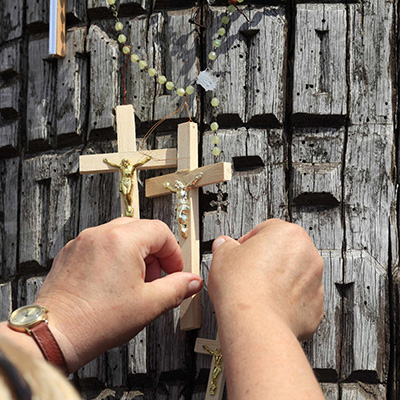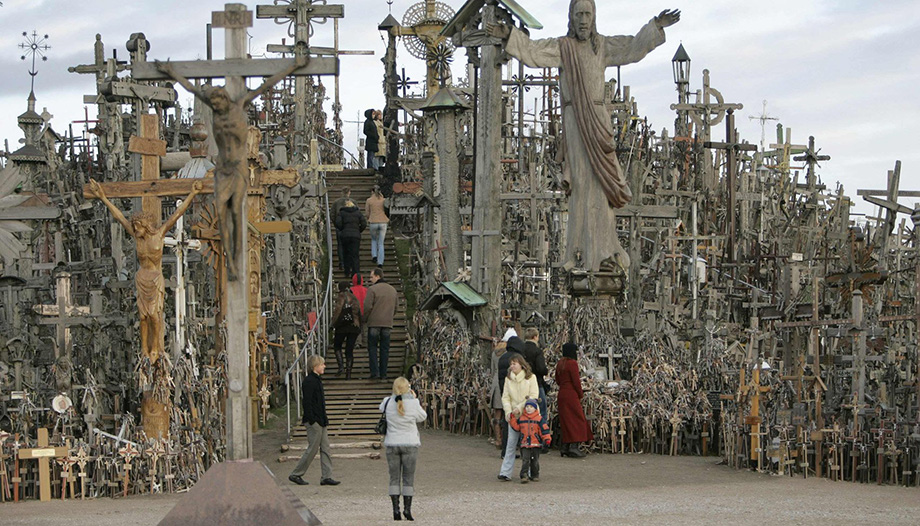The Hill of Crosses is first mentioned in writings of the mid-19th century. In 1850, Maurikis Hriškevicius, treasurer of Šiauliai, wrote: "People still attribute holiness to the Jurgaiciai mound. According to local research, it happened - that one of the inhabitants of Jurgaiciai promised God when he was seriously ill that, if he survived his illness, he would erect a cross on the hill. It so happened that he was cured while building the cross there. As soon as the news spread among the people, in a few years so many crosses were brought from distant villages and others were erected there that we can now see their abundance."
Stories about the Hill of Crosses
Later accounts tell that the crosses were built over the graves of participants in the uprisings of 1831 and 1863 two uprisings of the former Republic of the Two Nations against the Russian Empire known as "the November Uprising" and "the January Uprising", respectively.
The deceased were buried in the mound. This version of the erection of the crosses was especially widespread during the decades of the Soviet occupation, in an effort to downplay the religious significance of the Hill of Crosses and turn it into a monument to the resistance of the people against the exploiters.
However, with the first testimonies, it seems that the first crosses on the hill appeared as signs of sincere popular piety and gratitude to God which were joined by additional motives: the desire to honor the rebels buried here and, at the same time, to oppose the tsarist authorities who forbade and hindered the erection of crosses.
Under the czarist empire
By the end of the 18th century Lithuania had been incorporated into the Russian Empire. At this time the custom of erecting wooden crosses on roadsides near dwellings was already widespread throughout Lithuania.
In fact, the making of wooden crosses and crucifixes in Lithuania has been part of the Intangible Cultural Heritage of Humanity since 2008.
With the incorporation into the Russian Empire, these cruisers also became the symbol of Lithuania's national and religious identity.
In 1845, the Russian government prohibited the erection of crosses, except in churches and cemeteries.
The people resisted this decree, ignored it and continued to build their crosses, even managing to persuade local officials to take their side.
However, after the 1863 uprising, the prohibition was renewed, and only crosses on graves were allowed.
In 1878, Tsar Alexander II lifted the ban, but the official at the center who sent the letter ordered that it not be made public. Thus, the Hill of Crosses, which was born as a sign of sincere faith, became a sign of the strength and endurance of faith, despite suffering and trials.
At the end of the 19th century, the Hill of Crosses was already quite famous, mainly in the local environment.
This is shown in its appearance some maps or, for example, in the article that, in 1888, the Lithuanian-American newspaper Lietuviškas rafts wrote about the Hill, entitled On the small hills of Lithuania.
The spontaneous devotion of the faithful was supported and encouraged by the priests of the area, and also by those of more distant parishes. In 1888 a 14-station Stations of the Cross had already been built on the hill and by 1914 there were 200 crosses and a small chapel.
In 1918 Lithuania declared its independence. During the period of independence, crosses continued to be erected on the hill. People could gather to pray, celebrate religious services, pilgrimages and pilgrimages without being disturbed by anyone.
In these years there are reports of pilgrimages of up to 10,000 people. The number of crosses on the hill continued to increase and in 1923 there were already about four hundred.
The Soviet era
The Soviet occupation after World War II marked the beginning of a hard period in the life of Lithuania. During the Soviet era, the Hill of Crosses became a well-known symbol of the struggle for religious freedom, even abroad.
The more the occupying power tried to destroy the hill, even crush it, the more it flourished. The more efforts were made to suppress the erection of crosses, the more crosses were erected.
During the difficult decades of the occupation, the significance of the cross as a source of strength and hope was particularly evident. The Hill of Crosses was nicknamed the "Lithuanian Golgotha".
Little is known about the Hill of Crosses during the Stalin era, when repression and persecution were especially brutal. It is said that many crosses were placed at nightfall by the relatives of fallen partisans (fighters for Lithuanian independence).

After Stalin's death, the persecution of believers decreased in intensity and the authorities adopted a more relaxed approach to the erection of crosses. Between 1956 and 1959 alone, some 1,000 crosses were planted there.
In 1959 the persecution of Christians in Lithuania began again, manifested in the suppression of all manifestations of religious life, the closing of churches and the destruction of holy places.
The Central Committee of the Communist Party of Lithuania issued the resolution "On measures to stop mass visits to holy places". On the basis of this resolution a series of measures were launched with the intention of destroying the crosses erected on the hill.
In 1961 the Commission of Inquiry established that the hill and the adjacent spring posed a serious risk of spreading infectious diseases and that, in the opinion of the Commission, "the situation could no longer be tolerated".
On April 5, 1961, with the help of bulldozers and bulldozers from a nearby kolkhoz (collective farm), the crosses were razed from the hill by teams of prisoners and soldiers on the orders of the communist authorities.
The demolished wooden crosses were cut down and burned in bonfires; those made of cement and stone were smashed or buried in water; and those made of iron were taken away as scrap metal. All the crosses on the hill - 2,179 crosses made of different materials - were destroyed in one day. Although the hill was completely devastated, people were not afraid to put up crosses again.
The crosses returned to the hill, evading the vigilance of KGB forces. So many crosses were placed that, between 1973 and 1985, the Soviet authorities had to raze the hill four times. There were even plans to flood the hill to put an end to the problem.
The Hill of Crosses again grew in popularity in Lithuania in the 1980s and 1990s.
Many of the testimonies of faith linked to this place were described in the Chronicle of the Catholic Church in Lithuania, through which they reached the West, so that the struggle for the survival of the Hill of Crosses became widely known both abroad and throughout Lithuania.
St. John Paul II on the Hill of Crosses
Shortly after the recovery of independence in 1990, the most important event in the history of the Hill of Crosses took place: the visit of Pope John Paul II on September 7, 1993.
The Holy Father, together with the bishops of Lithuania, celebrated Mass in the chapel erected for the occasion in the presence of a large crowd of people (approximately 100,000).
In his homily, Pope St. John Paul II remembered Lithuanians who were sent to prison or concentration camps, deported to Siberia or condemned to death. Before and after the Mass he climbed the hill to pray in the impressive forest of crosses.
The Holy Father was especially moved by the fact that a cross was erected after the 1981 bombing praying for his health. "As that cross remains here, so the Pope's prayer remains with you. Your prayer for the Pope, who today has experienced a great grace in visiting this holy place, remains with him," he said.
Today, a large crucifix sent by John Paul II himself stands in the center of the Hill of Crosses and is the starting and ending point of many pilgrimages.
On his return from the Baltic countries, during his visit to the La Verna Franciscan monastery, John Paul II encouraged the Franciscans to build a hermitage on the Hill of Crosses. The monastery, which is only 300 meters from the hill, was consecrated on July 8, 2000.
In 1997 the diocese of Šiauliai was created and on July 20 of the same year, by the decision of the bishop, the pilgrimage to the Hill of Crosses, which is celebrated on the last Sunday of July, was revived. Since then, every year, many people from all over Lithuania, and from other countries, gather to celebrate the pilgrimage, which is usually attended by the Apostolic Nuncio and all the Lithuanian bishops.
Since then, many people every year place their crosses both as individuals and groups in commemoration of different events.
Both small, simple wooden crosses and large artistic crosses are placed. In 2007, more than 200,000 crosses were counted on the Hill. A place that has become a point of interest for devotion and tourism for visitors to Lithuania.











